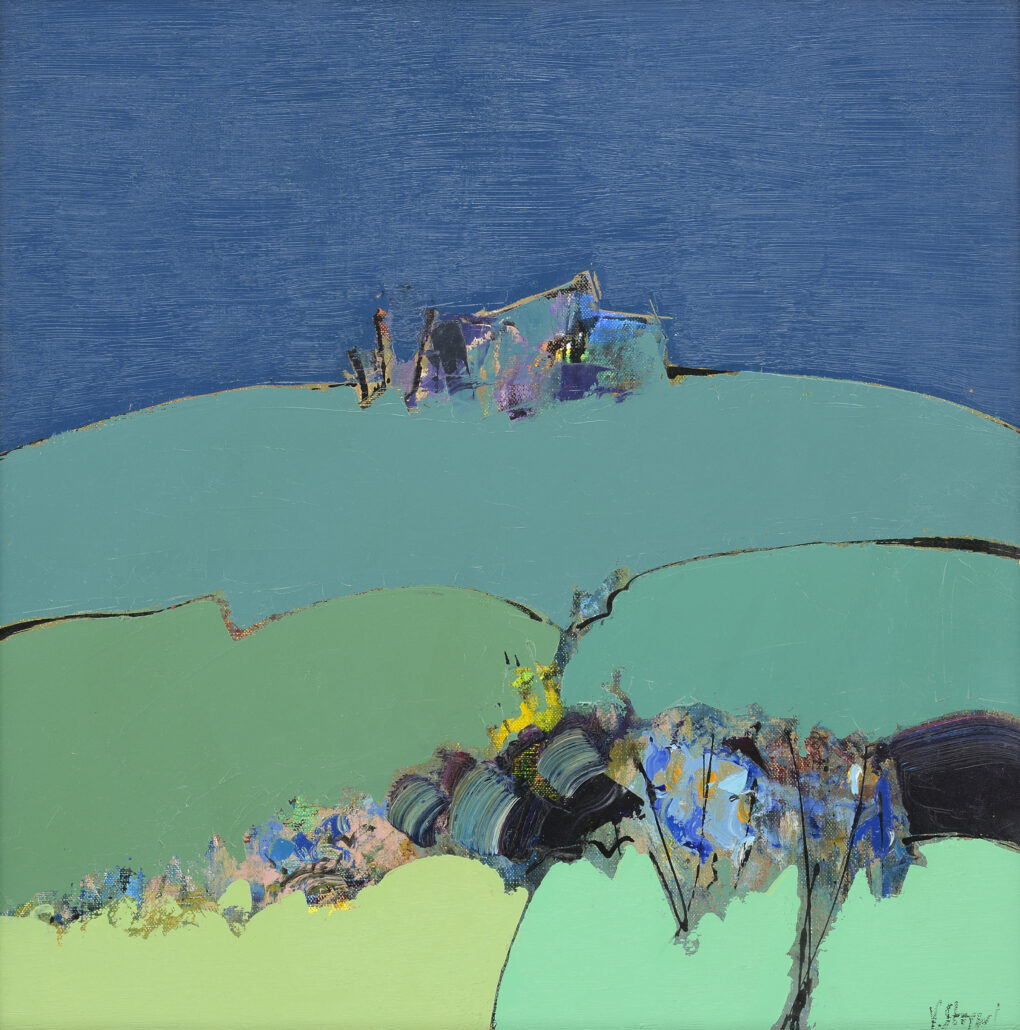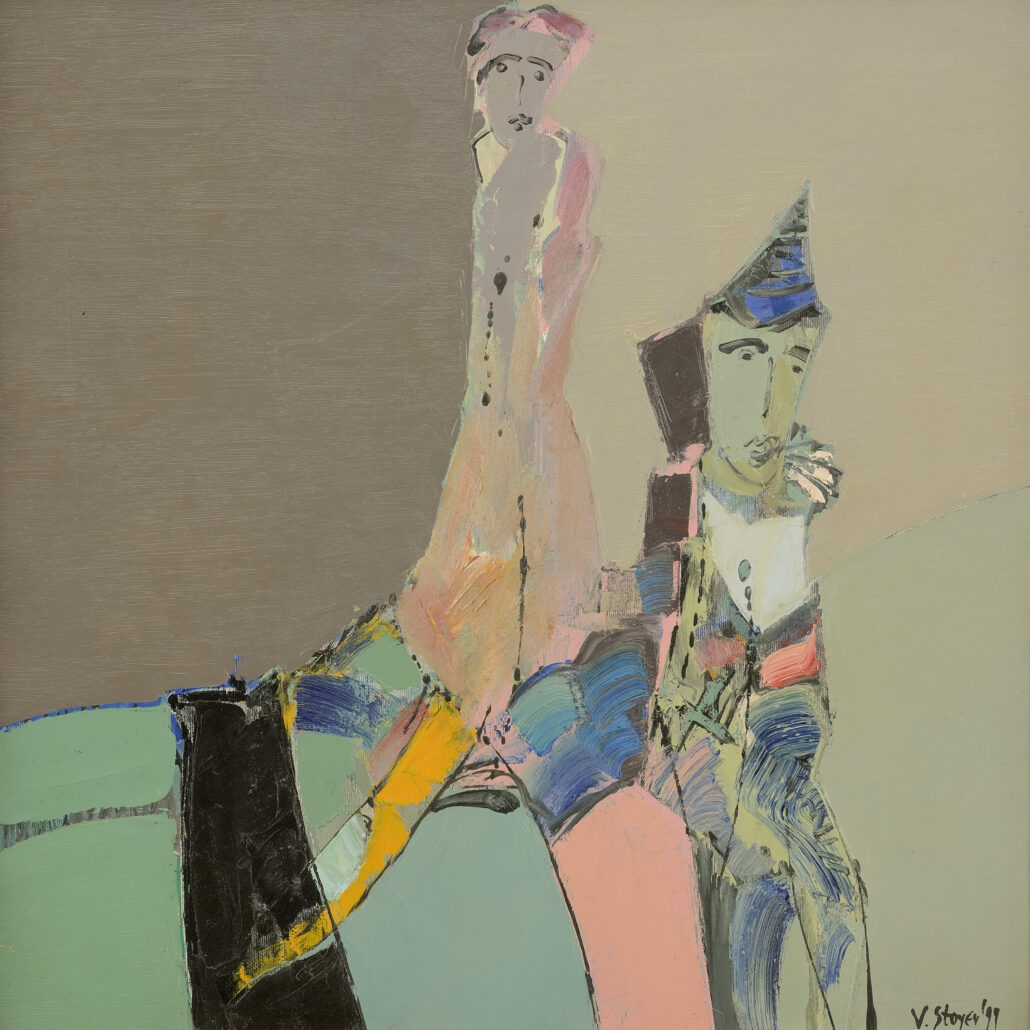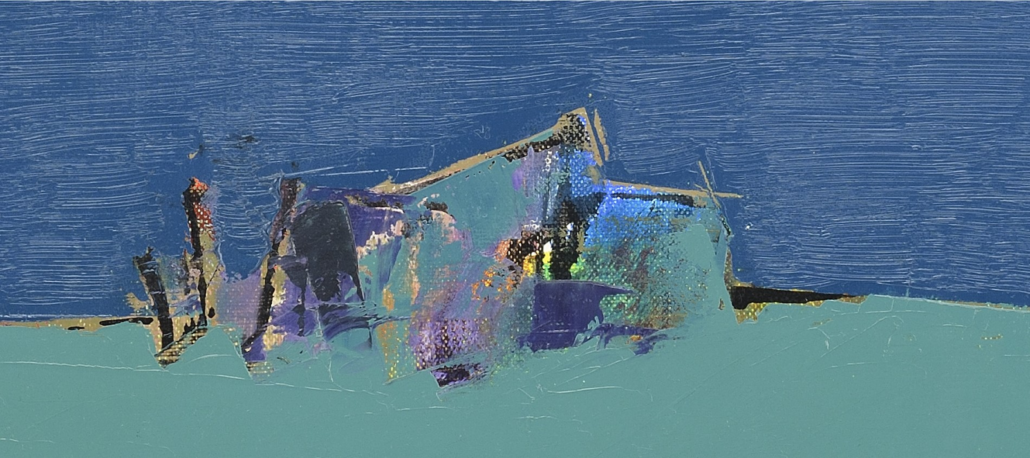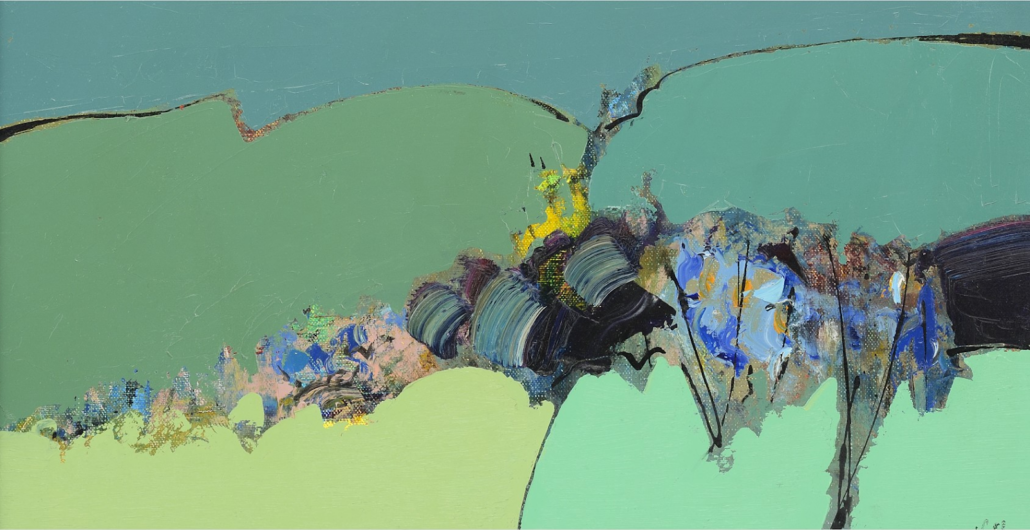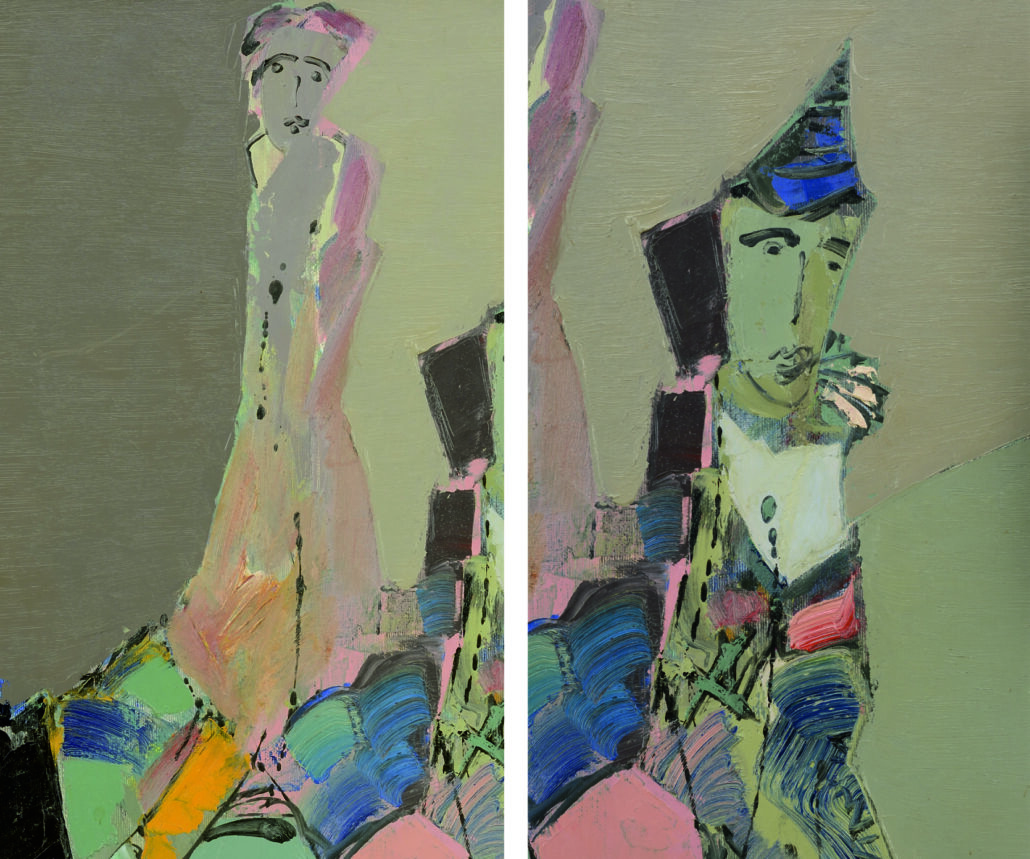Two oil paintings by Plovdiv artist Vasil Stoev, painted on the edge of the new millennium, are among the most exquisite jewels of the Spring Auction 2024. One is completely abstract and the other is narrative, with human figures in an emotional relationship. Both are rendered in his characteristic personal style, clearly recognizable not only among Bulgarian artists but also on the world scale.

Who is Vasil Stoev and what does he paint
Vasil Stoev was born on August 7, 1950 in the town of Parvomay, Plovdiv region. He graduated in applied graphics from the National Academy of Arts in Sofia, under Professor Alexander Popilov in 1979. His first solo exhibition was in 1981. Since then he has participated in about 100 solo and collective exhibitions in Bulgaria and abroad. He is one of the most appreciated contemporary Bulgarian artists abroad. He has exhibited many times in more than twenty countries. Museums and galleries in Malta, France, Switzerland, the Netherlands, Germany, Italy, Greece, Turkey, Belgium, Portugal, Croatia, the USA, Japan, etc own his works.
European and overseas gallerists and collectors recognized Stoev as a very young artist before he had even managed to win his place on the art scene in Bulgaria. In addition, this international success accompanies him to this day. In 1983, a Viennese gallerist noticed and invited him to exhibit solo in Vienna (Ognyanov 2023; Jazzit 2010). His exhibition was very successful – an American collector bought three of the works on the opening day. He is one of the few Bulgarian artists invited by Sotheby’s experts to present paintings at their auctions (Tringova 2023). His first appearance at Sotheby’s was in 1989, and both of his works presented at the London auction were purchased (Jazzit 2010). Thirty years later, he was invited again, this time for an auction in Vienna, where his painting sold after a long bidding process (Valcheva 2021).
Ivan Marazov makes one of the most insightful analyses of his work: ‘At first glance, Vasil Stoev’s paintings seem liberated, made in one breath, “sung”. … However, behind this apparent pictorial lightness lies an unsuspected energy of constructive principle. Moreover, it comes through in the organization of the composition. Even when the figure is completely absent, the pictorial structure is created out of contrasts. Most often, the loose, even chaotic bright strokes that form a textural “island” in the center of the canvas are juxtaposed with relatively smooth monochromatic surfaces. Another contrast is achieved by the juxtaposition of bright and pastel monotone patches. It is surprising how “silenced” tones can become a source of intense irradiation, how black or grey can lose their colourful neutrality and become deep colours. At last, too, the sudden appearance of a contour line, which does not portray but only emphasizes the characteristic in a figure, is imposed as a “graphic” emphasis on the pictorial magma. The effort to impose the structure of the amorphous and to extract meaning from it is at the heart of this painting and defines the individuality of Vassil Stoev.
The viewer tactilely feels the tension in the painting’s contrasts; he experiences, following the artist, the drama of opposition that finds an outlet in an enduring internal construction. This, I believe, is what charges the viewer with the energy invested in the making of the painting. In this way, his perception also becomes much more acute and active. That is why Stoev’s paintings are not “comfortable furniture”, they are energy points in the interior, saturating the atmosphere with the pain and exaltation of a purely pictorial drama. Vasil Stoev’s paintings can be perceived as a mirror in which we can pick out that picture of ourselves, overflowing with colours, in which the transforming circumstances of real life wander. This has always been the primary task of true art. It is not a decorative element, but on the contrary an existential touch of our inner truth” (Marazov 2016).“
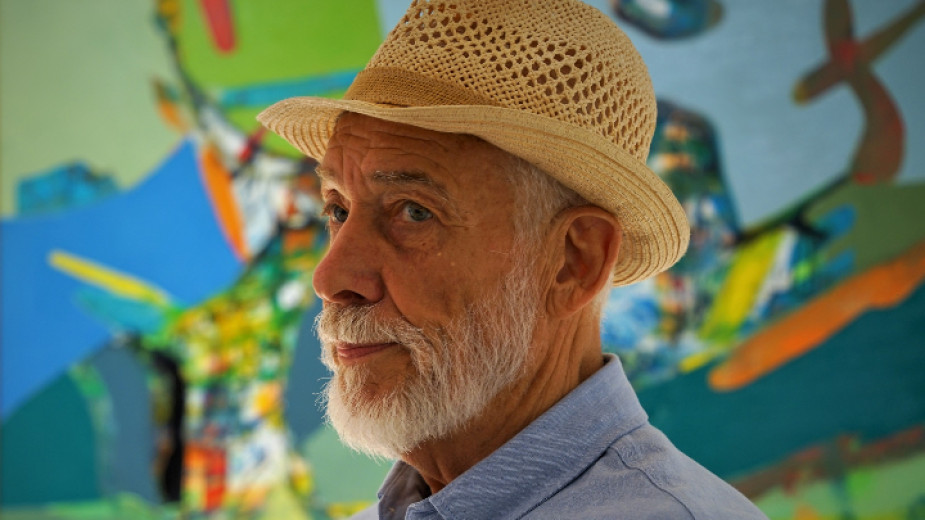
Vasil Stoev about himself and his work
The great thing about contemporary artists is that their lives and their words can be well documented with the tools of technology. This makes communicating with the artists, and therefore understanding them, completely accessible. Vasil Stoev is completely open; he speaks frankly about his life and art in front of the camera or in interviews, without hiding anything, even embarrassing and disturbing stories. They do help us understand more about his abstract art. “I am an abstract artist,” – says Vasil Stoev – “but not really, because in many of my paintings there are also elements of real things. Sometimes they are only hinted at, sometimes they are more concrete – it comes by itself, there are no rules in the process of painting” (Petrov 2007).
Here’s how he answers the question of when and how this confrontation that everyone notices in his paintings came about: “Day and night, good and bad, I didn’t think of it that way, but this confrontation came about in my work thanks to the major I studied – applied graphics. Moreover, the smooth spots that appear calm the painting to get a balance. Subsequently, things changed. My paintings are a little different now. Before they were in a darker palette, there was something more dramatic about them. Now they are more cheerful, more joyful, I do not know what it is. … At a certain point, there remains that inner deep emotional feeling in the artist that he used to have when he saw something and then transmitted it to the canvas. That is an emotion. Contemporary painting is much more emotional than it was concrete and definite as it was years ago” (Shekerletova 2016).
However, what all observers see as confrontation, war, battle or conflict is for him a search for balance, for rhythm, a search for a solution to the problem: “I like to mix several colours; I like to find the balance between the turbulent and the calm. I always try to have some rhythm, something going on. This is something characteristic of my style” (Valkova 2023). Musicians see-hear music in his colourful rhythms, scales and tones (Jazzit 2010). He himself says that music plays an important role in his work that he works with a classical music or jazz background (Shekerletova 2016).
Because of the form, Vasil Stoev’s paintings at first glance may seem mathematical and rationally planned, in fact, they are painted spontaneously, without preliminary ideas and drawings, and they are made on prima vista (Nova art 2020). That is why we included them in the group of works in the auction, which we united under the common theme “The World of Dreams“. This is how he describes his creative process: “Standing in front of the white canvas, I never plan in advance exactly what I am going to do. I let myself something to move my hand – I don’t know exactly what to call it, whether it is some inner impulses, intuition or perhaps forces to which each of us is subject.” (Tringova 2023).
Sources of inspiration and art as therapy
Stoev finds the creative source of his paintings in his childhood memories, he has repeatedly expressed it in films (Tringova 2023) and interviews: “Artists basically retain that childishness in their way of painting that they had. Pablo Picasso said if we could paint like children we would be the most genius” (Shekerletova 2016). His life fate was not an easy one (Tringova 2023). His childhood was marked by many traumas, which he talks about in several films (Jazzit 2010; Tringova 2023), but in his narratives he never concentrates on the unpleasant and distressing, but always notes some positivity even in the most unpleasant situation. Both in his stories about himself (Tringova 2023) and in his paintings it is evident that optimism is his constant companion and that he has always relied on it to overcome traumas and find solutions.

He does not remember his mother because she died young from an illness. The father was a driver, and because he travelled a lot and for a long time, he gave his son to an orphanage when it was time for school (Tringova 2023; Ognyanov 2023). Despite the distressing situation for Vasil – without relatives, without love and care – it was there that he began to paint (Jazzit 2010; Tringova 2023). The father took him back two years later when he married a second time. Stoev was overjoyed by this because he would finally have a mother, something he had dreamed of in the orphanage. Suddenly he got a big family – besides his sister, his second mother had a child from her first marriage, and a fourth child was born. Many children meant for Vasil Stoev a lot of fun. He says that he was happiest with his grandparents in the village in the summer (Tringova 2023). There he was captivated by events such as fairs and performances by travelling artists, which he loved to paint because memories of them proved fundamental in forming his ideas about the world (Jazzit 2010; Tringova 2023). Childhood images of clowns, harlequins, mime actors, and puppeteers are particularly frequently represented in his paintings (Jazzit 2010).
Despite the revelry in a family with many children, parental support seems to have been absent. Moreover, into adult life, Stoev continues to move in alone. His father did not approve of his career as an artist, and did not support him when he was accepted into the academy. After graduating from the academy, he stayed unemployed for a long time and barely managed to make ends meet (Nova art 2020; Tringova 2023). At that time he started painting, but for a long time his paintings were not approved for general exhibitions. With great difficulty, he was allowed to open his first exhibition in 1981. The day after the opening, he found his paintings taken down, dumped by the door of the toilet, because renovations had begun in the hall (Jazzit 2010; Tringova 2023).
In the times before 1989, and at the beginning of the transitional period, the socialist leaders who ruled artistic life disliked him. He met Svetlin Russev by chance during his first exhibition in Vienna in 1983, where Russev passed through on his way back from Paris. Stoev was not well received and then Russev cut him from participating in exhibitions (Jazzit 2010). From 1983 to 1989, Stoev was not allowed to participate in general exhibitions or exhibitions abroad, until two of his works were selected for auction at Sotheby’s (Jazzit 2010; Tringova 2023), where the great success of buying works by Bulgarian artists happened for the first time (NOva art 2020) . This was followed by a worldwide furore and for some time afterwards – in his homeland also. Today, both worldwide and in Bulgaria, Stoev has many collectors (Jazzit 2010; NOva art 2020), whom we hope to bring delight at this auction.
It is striking that despite his enormous success on the world stage, the great artist remains too modest and humble when speaking about himself (Ognyanov 2023; Tringova 2023). The usual egocentrism and overconfidence so characteristic of most artists are absent (Jazzit 2010). All who know him say that he is a bohemian, cheerful, kind, sincere and warm-hearted person (Jazzit 2010). Moreover, for him, as for many other artists with a difficult life, art and the creative process have clearly played a fruitful art therapeutic role in overcoming a traumatic past. Certainly, thanks to the constant creative process in which he immersed himself, he has preserved himself as an optimistic and loving person. He has repeatedly spoken of loving being one of the most important values for him: “In my opinion, one should be in love all one’s life. If you don’t love the people around you, if you don’t love life, then what’s the point of everything?“(Tringova 2023). “My heart will always be in Plovdiv, in this city, where my friends are, where not only my childhood passed, but also most of my conscious creative life path. I love both the city and the people and I would never replace them with anything else. … The most important thing, in my opinion, is to love the city where you grew up, where you were nurtured with a love for art. To love the people with whom you took your first steps, with whom you developed, created and bohemianized” (Tringova 2023).
Vasil Stoev’s paintings in the Spring Auction 2024
Two oil paintings by Plovdiv artist Vasil Stoev, painted on the edge of the new millennium, are among the most exquisite jewels of the Spring Auction 2024. One is completely abstract and the other is narrative, with human figures in an emotional relationship. Both are rendered in his characteristic personal style, clearly recognizable not only among Bulgarian artists but also on the world scale.
The more abstract composition “Twilight”, 2002, is not extremely abstract, as Vasil Stoev himself says about his work: “I am an abstract artist, but not entirely, because in many of my paintings there are elements of real things. Sometimes they are only hinted, sometimes they are more concrete – it comes by itself, there are no rules in the process of painting.” (Petrov 2007). First, we are quite definitely talking about the genre of landscape, which is one of the artist’s favourites and is linked to his most inspiring childhood memories. He says the following about one of his exhibitions: “Yes, there will be landscapes, but this time they are relatively fewer. I’ve also done a series that I’ve called “Late Afternoon”, which is of my sentimental childhood memories.” (Tringova 2023). Second – while the forms in the foreground are completely unrecognizable, the forms in the background are reminiscent of a building, of a house. At first glance, it seems to be half-destroyed, but at a second glance, we notice some light, as if from a luminous window. Although vague, a somewhat recognizable image exists in the background, and it is in tune with the genre of the landscape. Third, the title “Twilight” indicates the time at which the landscape was probably painted with the rounded, possibly Rhodopian, spring hills – also a much loved natural landscape for Stoev.
Where the abstractness in his compositions comes from. The artist loves to paint the time. Huge amounts of his paintings have titles for time – morning, dawn, early morning, twilight, afternoon, late afternoon, evening. To represent time is quite difficult to achieve in fine art, and to do so not through the subject matter but precisely through abstraction. In the years after 2002 Vasil Stoev very often painted landscapes in the late afternoon or twilight, in which light and darkness shift, twilight creates bizarre visions of objects, emphasizing some elements of them and hiding others, just as it happens in our dreams. This transitory time combines the not-yet-vanished light of the sky and the artificial lights appearing in the windows – as we see in the second plan of the painting. The transitional time between day and night predetermines the more intensified abstraction in the multi-coloured patches and textures in the centres of both planes. Perhaps it is from the nature of this time of day that Stoev draws the strange shapes, colours and textures in his abstract compositions.
In this work, some typical and very recognizable characteristics of Vasil Stoev’s personal style are very vividly manifested. As he himself explains, a balance and rhythm is presented between the monotone panels – here moving from warm greens, through cold greens, cold blues and warm blues. On the other hand, a balance and rhythm is established between the monotone panels and the brightly textured and multi-coloured patches and shapes in the centres of the two planes in the composition. Although Stoev claims that he does not do these things in order to portray oppositions (Shekerletova 2016; Valkova 2023), I think it does occur, albeit unconsciously. Balance, rhythm and the flow of time cannot be expressed by identical or similar things, but only by opposites.
To these characteristics of the style, noted by many, I would add one more. In the seemingly highly two-dimensional space of the paintings, I also see an illusionary three-dimensionality that is clearly visible in this landscape – we have two, even three planes of hills set in rows behind each other. Yes, the perspective is quite distorted, in some places it is even reversed, but it is there. Moreover, I see not only three-dimensionality, but also four-dimensionality – a completely fantastic, otherworldly four-dimensional space has been constructed. The fourth dimension is clearly visible when we bring our eyes closer to the places where the monochrome panels touch the multi-coloured central patches (Ivan Marazov describes them as a “painting collage” – Marazov 2018).
We see up close that Stoev constructsthe one-toned panels in such a way that they seem to be able to move horizontally in and out, and in this movement to cover or uncover a view of the multi-colored concentrations of forms that lie in the space deep beneath them, not at all illusory. It is because of this covering uncovering that we are more often unable to decipher what we see in these cracks, because the whole or at least a significant part of the view of the objects beneath the planes (in this case, beneath the ground) is not revealed to us. In some cases, when the artist has brought the surface of the planes too close to the level of the multi-coloured forms, in their inward movement the planes also pick up some of the multi-coloured forms with their edges, nudge them, displace them, crush them, squeeze them, and push them upward towards our view. They do this in much the same way as do the plates in the Earth’s crust, which in their movement push up lava from the Earth’s mantle and produce erupting volcanoes. In these cases, the multi-coloured forms rise up in a three-dimensional texture, and sometimes overflow or pour over the surface of the planes. This is demonstrated in the right-hand half of the foreground, with the pointed linear shapes in a predominantly blue palette – they have emerged from beneath the green plane, flowed over it and poured down into the pictorial field. What exactly they are, what they are pieces of – only Vasil Stoev can tell us. Although even without knowing what they are, they look magnificent.
What can the artist be telling and demonstrating to us with these abstract moving paint constructions – for example, that time, as a fourth dimension, changes space and matter and how exactly this happens.
In what I called the half-destroyed house in the background, another trick of Vasil Stoev is demonstrated. In his collages, he often scatters what seem to be broken glass-mirrors that break the images, change them beyond recognition or hide parts of them. In this case, the two frames that surround the small light actually reflect the blue of the terrain in their lower and lateral parts, and the dark blue of the sky in the small corners of their upper parts. Somewhere behind, the obscure object’s own colour is seen to be violet. With these broken glass-mirrors on it, we cannot tell what it is in reality. However, it also looks wonderful in its unrecognizability, even if only because of the light.
The second oil canvas by Vasil Stoev in the auction, which we have called “Distancing”, 1999, is easier to read because it is figurative. Two figures – male and female – in an obvious relationship stand on either side of the corner of a large bed. The figures and the double bed are the multi-coloured textured patches that, unusually for Stoev, occupy not any cracks in this painting but half the pictorial field. Although they are large, they, like the figures in the cracks, are squeezed in and partially covered by the monotone panels (their hands are not visible). The male figure is in a cool shade of blue-green, which is also represented in the colours of the bedroom cover. The female figure is in a warm pink-violet-yellow-orange palette, which also has its correspondence in the colours of the bedroom cover. His blue and her pink-yellow go beyond their bodies and cross over the bedroom, then reaching and stopping at a huge black band encircling the entire bedroom crosswise.
The man sits in the foreground in a low position, folded into himself, his back to the woman. She is standing behind him, away from him, on higher ground. She is heading to the left, but has turned her head and gaze sideways and slightly back towards him, unsure if this is really the last time. She goes from a light green-greyish plane-world to a dark green-grey plane-world, from a livelier to a lifeless plane. He sits, his back against some dark rectangular-shaped material (the back of a chair shaped out of bricks?), at the meeting point of her light green-greyish plane-world, his pastel green plane-world, and the pink of the bedroom, which is also the pink of her clothes. He has no contact with the lifeless dark-green-grey plane-world she is headed for, not even a glance at it. He is staring at his point of sadness, located outside the pictorial field, to the right of us, the viewers.
With their poses and facial expressions, they both show us the same thing – an unwanted but inevitable distancing, perhaps a separation, is taking place between them. Both are humbled-reconciled, he more so. Both are immensely grieved. However, both will do nothing to change what is happening, perhaps because they are unable to change anything.
Of course, Stoev may have represented some particular distancing or separation. He may have represented – abstractly, conventionally and universally – the alienation and separation between man and woman in general. However, since it is certainly not a separation in which one is guilty and the other is not, or in which there is aggression and accusations against each other, but it is an inevitability against which nothing can be done, perhaps the usual situation in relations between a man and a woman is not represented here. We know that for Vasil Stoev childhood is very important for his art, we know that childhood memories are the most inspiring for him (Tringova 2023; Shekerletova 2016). Therefore, I think we have reason to think that, even unconsciously, he has represented at least in part the emotion and experience of the most traumatic separation for him – the death of his mother.
Apart from the elements already described which point towards withdrawal forever – the high dark space, the black tape encircling the bedroom – we should also pay attention to the characters’ clothing. Her very elegant and beautiful clothes are close to the fashion and women’s silhouette of the 1930s-40s, and Vasil Stoev was born in 1950. The man in the painting has small elements of clothing that are typical of clowns – a collar, a hat – as if he had not managed to take off all his clown attributes when he came home. In all the stories about himself and his childhood, the artist never fails to tell as the most impressive for him the stories about travelling artists who used to visit his grandparents’ village to give performances. He helped them a lot in their organisation (Jazzit 2010; Tringova 2023). It has already been mentioned that childhood images of clowns, harlequins, mime actors, and puppeteers are the most frequently represented in his paintings (Jazzit 2010). He himself is a bohemian, with a wonderful sense of humour, loves the pleasure of socializing, and loves laughter and fun. Perhaps the complex personality of the clown in his paintings is often an image of himself.
Of course, it cannot be ruled out at all that in this painting Vasil Stoev represents some concrete real love distancing or separation. He certainly presents in an abstract and conditional way the universal situation of distancing and separation between man and woman. But what is specific about it is that the model is formed on the separation from his mother, in which no one was to blame, which separation-death was equally unwanted by both, but was inevitable, which is why it is most useful to be able to humbly come to terms with it. The pattern of separation in his painting is not ugly, aggressive, narcissistic, selfish or accusatory, as we most often see in male-female relationships. In his particular pattern, the aristocracy and beauty of human relationships, his kindness and graciousness, and even the optimism that sustains both his world and himself are on display. With such works of his, the artist could help us, give us a model of how to support both our worlds and our human relationships, how to protect them from ugliness.
It is no surprise that Vasil Stoev is so well appreciated and his paintings are purchased both in Bulgaria and around the world. His compositions, forms and colouring radiate calmness, confidence, serenity and optimism, even when they represent the saddest and most distressing situations. He is able to do this because, having struggled with his hard destiny for at least half of his life, he has learned to seek and find solutions to emotional and existential problems precisely through the process of artistic creation. The creative process, for him in a subconscious way (Nova art 2020; Tringova 2023), always arrives at pointing to solutions, which however you must be able to both see and understand. Vasil Stoev lovingly and graciously shares with people the solutions he finds through his paintings, which is why he has so many admirers and connoisseurs all over the world. We hope that the two works of his in the auction will find the right people to inspire with paths of confidence, hope and positive solutions.
Rossitsa Gicheva-Meimari, PhD
Senior Assistant Professor in the Art History and Culture Studies Section and member of the Bulgarian-European Cultural Dialogues Centre at New Bulgarian University
April 2024
Bibliography:
Valkova 2023: Светлана Вълкова, 2023. Васил Стоев: Между сянката и светлината стои творчеството. В: БНР https://bnr.bg/post/101852367/vasil-stoev-mejdu-sankata-i-svetlinata-stoi-tvorchestvoto
Valcheva 2021: Нели Вълчева, 2021. Арт Галерия “Ларго” и Васил Стоев – “Вчера, днес и утре”. В: Impressio https://impressio.dir.bg/palitra/art-galeriya-largo-i-vasil-stoev-vchera-dnes-i-utre
Marazov 2016: Иван Маразов, 2016. Освободените картини на Васил Стоев, изложба в галерия “Тереза Зиковска” от 25.04-15.05. 2018 г. в: Sofiapress https://sofiapress.com/galleries/osvobodenite-kartini-na-vasil-stoev/ , https://sofiapress.com/artists/dinamika-i-cvetove-v-jivopista-na-vasil-stoev/
Marazov 2018: Иван Маразов, 2018. Откриване на изложба на Васил Стоев в галерия „Импресия“ през 2018 г. в: Youtube канала на www.MapVIO.com
Ognyanov 2023: Любо Огнянов, 2023. Художникът Васил Стоев: За болезнения път към красотата и изкуството. Интервю, В: “Офанзива с Любо Огнянов” https://youtu.be/um67qAH9Au4?si=SYzqqdmyo1o3dvFh
Petrov 2007: Лаврен Петров, 2007, Изложба „Васил Стоев – живопис 03.05.2007 – 17.05.2007“ в: сайт на галерия Лоран https://www.galleryloran.com/bg/exhibitions/view/vasil-stoev-jivopis
Tringova 2023: Ваня Трингова, Владислав Севов и Станимир Навущанов 2023. Коридори на съдбата. Филм за художника Васил Стоев https://youtu.be/b69CSkayHBQ?si=JbeRKet9mwMBjhqt
Photo of V. Stoev 01: Фотография на В. Стоев 01: Я. Шустов, източник БНР – https://bnr.bg/post/101852367/vasil-stoev-mejdu-sankata-i-svetlinata-stoi-tvorchestvoto
Photo of V. Stoev 02: Фотография на В. Стоев 02: Europlovdiv.com https://europlovdiv.com/vasil-stoev-otkriva-samostoyatelna-izlozhba-vv-viena/
Photo of V. Stoev 03: Фотография на В. Стоев 03: „Марица“ – https://www.marica.bg/kultura/vasil-stoev-na-70-hudojnikat-premina-koridorite-na-sadbata-i-pusna-kotva-v-german
Shekerletova 2016: Славена Шекерлетова, 2016. Васил Стоев: „Съвременната живопис е по-емоционална, отколкото конкретна“. В: Mediacafe https://www.mediacafe.bg/interviu/Vasil-Stoev-Syvremennata-zhivopis-e-po-emotsionalna-otkolkoto-konkretna-11579/
Jazzit 2010: Jazzit, Angelov, Pervolarakis, Fürhapter 2010. Васил Стоев – вибрацията на една нация. Филм. В: Youtube канал на www.MapVIO.com – https://youtu.be/VNs5d1_Ff_0?si=y5G7OtQGV5rpm8LZ
Nоva art 2020: Nоva art space в ателието на художника Васил Стоев https://youtu.be/XLeouks7aQQ?si=d2t3nc0Qigt4C9-K

